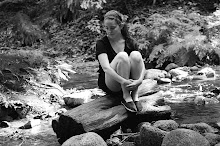All of Allen Ginsberg’s pieces resonate with the idea that within America is a lost hope. Even in the city of San Francisco, which Lawrence Ferlinghetti makes seem like an enchanted floating body of land, Ginsberg sees a landfill, littered with “black treadless tired forgotten and untreaded, the poem of the riverbank, condoms and pots, steel knives, nothing stainless…” (21-24). Although there is despair, hope (usually in the form of flowers) seems to rise out of his work as well. In his poem, “Sunflower Sutra”, Ginsberg finds beauty and inspiration in a lone sunflower amongst human debris. The bleak description that the piece is started with extends past the landscape, and into himself. Not only does his disappointment lie in the mechanical, dirty world around him, but he is also disappointed in himself, only an “old bum on the river bank” (13-14). His outlook is changed when a sunflower is pointed out to him, “a dead gray shadow against the sky, big as a man” (15-16). The sunflower is described as if it is a man, “leaves stuck out like arms…a dead fly in its ear” (35-37). The flower, which Ginsberg envisioned as much more majestic, is covered in dirt, or not even dirt: “artificial worse-than-dirt – industrial – modern” (45-46). He goes on to note the trash it is growing out of, but becomes astounded at its existence in such a bleak place. Among “rubber dollar bills, skin of machinery…worn out asses of chairs and sphincters of dynamos” (50-57), “a perfect excellent sunflower existence” (61-62). Soon it is not the sunflower that is a man, but man that is the sunflower, and he is warned of his ignorance: “We’re not our skin of grime, we’re not our dread bleak dusty imageless locomotive, we’re all beautiful golden sunflowers inside…growing into mad black formal sunflowers in the sunset” (82-87). Ginsberg does an excellent job of documenting the human horrors we let root into the earth, but also of filling the desperation that is affiliated with that horror, with hope.
(all of the sudden this is way more summary than close reading...sorry)

2 comments:
I definitely agree with you that Ginsberg just seems to see a landfill where Ferlinghetti sees an enchanted island. Ferlinghetti just seems more idealistic in his poetry, Ginsberg seems to have some personal grudge against the city, or maybe he just likes a very truthful representation of the city and his experiences there. Either way, you have to love Ferlinghetti's imagery when he describes "this far-out city on the left side of the world."
Katie...ok, but it's a pretty mean summary! I think you've hit upon one of the key Ginsberg moves - intense bleakness, maybe even despair. But out of the despair, identification. It's as if the identification gives the speaker the motivation to try and envision hopefulness. And why not, right? I like what you say about the disappointment the speaker finds in himself, as a parallel to the disappointment with society in general...
It'd be interesting to trace the dynamic across the Ginsberg works - what does hope look like? Is the problem with the speakers problem of mindset? Is it actually hopeful, or simply grasping for a shred of hope in the face of the industrial and all the other "weights of the world" (although, in another poem, he says the weight of the world is love...)?
Echoing line... "Moloch in whom I sit lonely!" Total horror.
Post a Comment